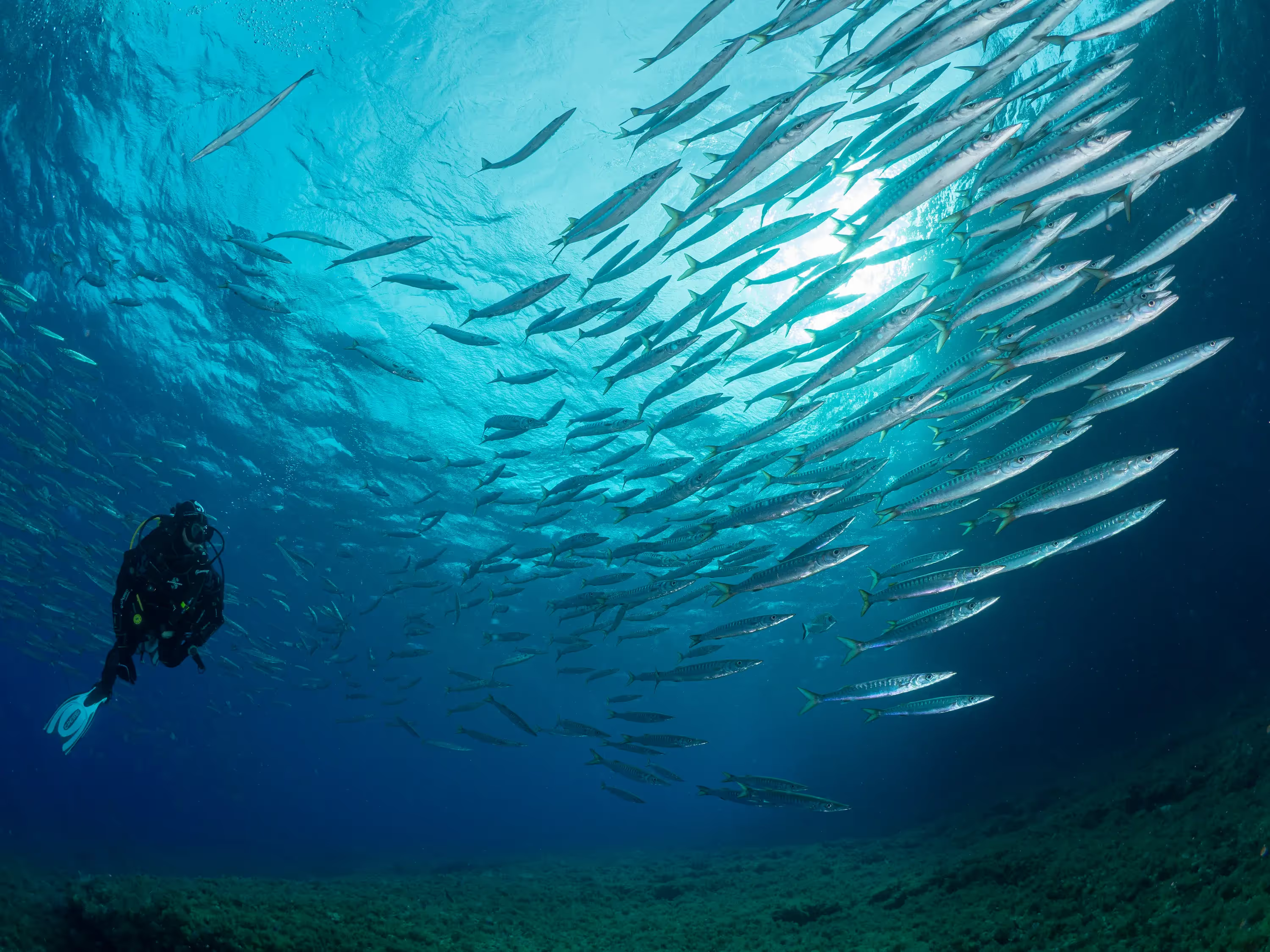
Compared to the rest of the Mediterranean, the Balearic Islands, like Corsica, Sicily, or some Greek islands, are doing relatively well in part due to the existence of a network of marine protected areas which is working well but it's not enough, nor is it properly funded. Despite the fact that the Balearic Islands are the best students in a class where all students are failing: we are far from where we should be! Twenty percent of the Balearic Sea is protected, but only 55 km2 - or 0.07% - is highly protected, meaning all fishing (professional and recreational) is prohibited. The European target is to have 30% of marine protected areas and 10% highly protected by 2030.


In protected zones, there are more fish and greater biodiversity. The government just completed a study in Ibiza in which the results showed that In the most protected area, there are twice as many fish as in the rest of the area and four times as many as outside the reserve. Fishermen working near these protected zones benefit from this as well as other local businesses and citizens. The sea recovers quickly. Within two years, we already see improvements.
The Balearic Islands are under extreme pressure. If we do nothing, we will lose the treasures that we have beneath the sea. We can make the Balearic Islands a global reference in marine conservation. If we achieve this with such demographic pressure and international visibility, we will create a model that can be inspiring for everyone. This is our challenge at the Marilles Foundation.



There are over 500 km2 of seagrass meadows in the Balearic Islands; this is half of all seagrass meadows in Spain. It serves as a refuge and nursery for many fish species : over 400 different species live in the sea around the Balearic Islands. Bluefin tuna come here to reproduce, sperm whales, the second largest whale in the Mediterranean, reside in the Balearic waters, for example, off Cabrera or in the north of Menorca. The Balearic Islands are the only place in the Mediterranean where there is commercial lobster fishing. Grouper, which is very scarce on the mainland, are regularly caught here. Grouper and lobster are good indicators of ecological health. Finally, researchers have discovered 5 new fish species in the last 30 years. They are small and not very beautiful, but still.
Yes, we have lost many species. Sharks and rays are becoming rarer. Angel sharks or guitarfish, species that combine the flattened face of a ray with the fins of a shark, were swimming in our waters in the early years of 2000 but they are no longer seen. In the Canary Islands, where angel sharks are still present in good numbers, they are extremely popular among divers. It's estimated that this niche tourism generates 4 to 5 millions euros in revenue. We have lost species because of fishing and habitat loss due to human pressure. Angel sharks or guitarfish reproduce very slowly and have few offspring. Fishing, although reduced, is the activity with the greatest impact on the sea. Twenty years ago, there were 1000 fishing boats in the Balearic Islands; today, there are only 300. Trawlers, which can be very damaging, number only 30, compared to 100 twenty years ago! Fishing is a difficult profession that no longer attracts young people. However, fishing as a leisure activity still appeals.
No, I enjoy fishing too! The real problem is illegal fishing and poachers. Many people come at night to marine protected areas. They fish for groupers, red mullet, breams, octopus, sought-after species that they sell to restaurants. This business allows them to earn 3000 to 4000 euros per month. We cannot accept setting up protection only to have our resources plundered. It's a misuse of public funds. We must collectively combat illegal fishing. The marine protected area North of Menorca has very poor results; we believe it's due to illegal fishing and poor control and enforcement. Menorca is a leader in sustainability but when it comes to marine protected areas it manages them very poorly.
Pollution, meaning everything we dump into the sea—plastics, waste, poorly treated sewage—as well as the increasing density of boats, damages the sea. The capacity of the island's sewage treatment plants has not kept up with the increase in tourists: it's astonishing that the Balearic Islands continue to close beaches in the high season due to sewage discharge! Another major problem is the warming of the waters. The Mediterranean is the sea warming most rapidly of all. In 2022, there were five underwater heatwaves; the water even reached 33°C. The environmental consequences are the same as those of a fire. Corals, gorgonians, sponges disappear. This also affects seagrass meadows, whose mortality increases when the water reaches 28°C. As for fish, they flee the heat and seek refuge in deeper waters.
The coastline—where a variety of different natural environments coexist—concentrates all human activity. The pressure on a single point is enormous. The more people there are on the islands, the more coastal infrastructure there is—piers, docks, beach bars... Bays, shallow and with low water circulation, are also very sensitive to any impact. They heat up very quickly because the volume of water is low. This increases the chance of algal blooms and green waters are not a good sell to tourism.
The Balearic Islands have an unresolved conflict regarding demographic pressure. We live in a highly polarized world where it's difficult to have a calm conversation about controlling tourism. We should have a cross-party agreement , as we did to end terrorism, signed by all political parties to protect the marine environment and manage the volume of tourists on the islands. Last year we launched the Balearic Blue Deal , a roadmap for marine conservation: 200 companies have signed it. But it seems that there is not yet the political maturity to implement it. The five commitments of the Balearic Blue deal include:
-Establishing a network of highly protected marine areas covering 10% of the Balearic Sea.
-Implementing plans for the conservation and recovery of vulnerable habitats and species.
-Ensuring sustainable fishing practices and putting an end to poaching and fraudulent trade.
-Improving the quality of our coastal waters.
-Investing a minimum of 1% of public budgets in marine conservation.*
(*) this is additional to expenditure in water treatment and infrastructure
Visit www.marilles.org to learn more about the foundation and how you can support its projects.











